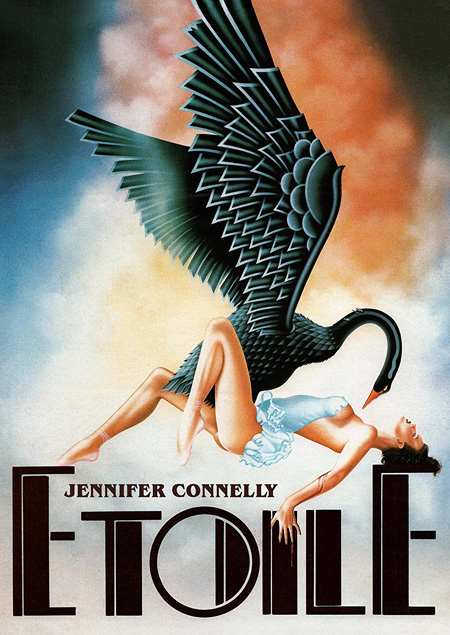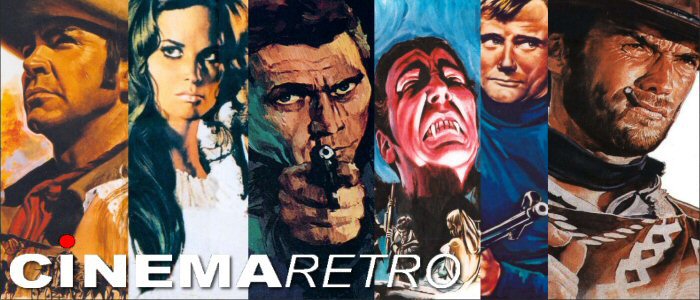
BY TODD GARBARINI
In the
summer of 1992 I visited a neighborhood thrift store that rented obscure videos
of movies made all over the world. Foreign films on laserdisc imported from
Japan were transferred to VHS and rented long before “online downloading†became
a household term. One of the films was relatively new yet unfamiliar to me
although the cover art featured actress Jennifer Connelly on it. I already knew
of her from her roles in Dario Argento’s Phenomena
(1985), Seven Minutes in Heaven
(1985), Labyrinth (1986), Some Girls (1988), and The Hot (yowzah) Spot (1990), but this title looked quite different. Etoile, the French word for “starâ€, is
the title of director Peter Del Monte’s relatively unknown and overlong 1989
dramatic thriller that easily calls to mind Darren Aronofsky’s superior Black Swan (2010) due to its theme of a
troubled ballerina. I would almost consider Etoile
to be a “lost†Jennifer Connelly film in that most people are unaware of it. Even
this video tribute to her
on Youtube skips it completely. Although Italian and filmed in spoken
English, the film was not released in either Italy or the United States. Ms. Connelly, who premiered at the age of twelve in Sergio
Leone’s Once Upon a Time in America
(1984) as a dancer, plays Claire, a New York-based ballerina visiting Budapest
to audition for Swan Lake. Like in
the opening of Phenomena, her
character is arriving in a foreign land by way of aviation and finally by taxi.
She bumps into a fellow New Yorker named Jason (Gary McCleery) after dropping
her slipper in the hotel she is staying at. He’s instantly smitten with her,
and who wouldn’t be? At just seventeen, Ms. Connelly is utterly breathtaking. The
ballet school is run by Marius Balakin (Laurent Terzieff, who bears a striking
resemblance to Pierre Clementi for those Bertolucci fans of you out there). Claire
ventures out into an old, decrepit theater and dances alone until she locks
eyes with Balakin who is sitting in a seat, looking around at the theater. She
bolts. In the meantime, Jason is learning the antiques business from his Uncle
Joshua (an unlikely Charles Durning), but cannot stop thinking about Claire and
sneaks off, accompanying her on a sojourn to an abandoned old house that used
to belong to a ballerina who danced in Swan
Lake. Compelled to succeed, Claire decides to audition.
At
this point the film takes a turn into seemingly supernatural territory when
Claire finds flowers delivered to her room and addressed to “Natalieâ€. Despite
her best efforts, she cannot locate anyone else in the hotel with that name. In
the middle of the night, she receives a visit from her teacher’s choreographer
and another dancer; understandably freaked out, she then decides to return to
New York. While at the airport, a P.A. page for a one “Natalie Horvath†sends
her into a trance and she almost willingly assumes the “role†of this person
and transforms into a ballerina, with no memory of Claire, her former self. Jason
locates her sitting by a lake and is hurt and bewildered by her demeanor and
failure to recognize him. Determined to get to the bottom of this, he goes to
great lengths to uncover this very obvious transformation that he is powerless
to explain let alone comprehend.
Director
Peter Del Monte’s best-known film to Americans is indubitably Julia and Julia, the 1987 Sting-Kathleen
Turner outing that was touted as the first film to be shot in high definition
(it was later transferred to 35mm for theatrical exhibition). The premise of
that film also called into mind the sanity of the protagonist, however here
Claire merely appears to be a confused and unwilling participant in a world
that simply pulls her into it. Although Claire and Jason’s love story isn’t
very compelling, I couldn’t help but feel sympathy for him and ended up rooting
for him. The ending is trite, even by the director’s own admission, which he
found unsatisfying. Jurgen Knieper, the film’s composer who has done some
wonderful work for Wim Wenders, provides a very effective and haunting score
that remained with me days after seeing the film, in particular the main theme.
The cinematography is also quite stellar as Acácio de Almeida’s camera reveals much
more than the laserdisc ever showed, mostly because this new transfer to DVD is
made from a new 2K scan of the original film elements with extensive color
correction performed. The image is framed at 1.85:1.
The
DVD from Scorpion has several extras. First up is an eighteen-minute interview with the
film’s director who discusses the challenges that he was forced to deal with
while making the film. He took the job as the producer gave him an advance,
which is something that he never had before. However, there were many
disagreements regarding the film’s tone, etc.
The
second extra is an on-screen interview with the film’s executive producer, Claudio
Mancini, who has far less positive things to say about the cast and the whole
experience. This runs just shy of ten minutes.
The
final section contains trailers for the following films: Etoile (1989), Barbarosa
(1981), City on Fire (1979), Steaming (1985), and Ten Little Indians (1974).
I
would recommend Etoile wholeheartedly
to Jennifer Connelly completists.
CLICK HERE TO ORDER FROM AMAZON
